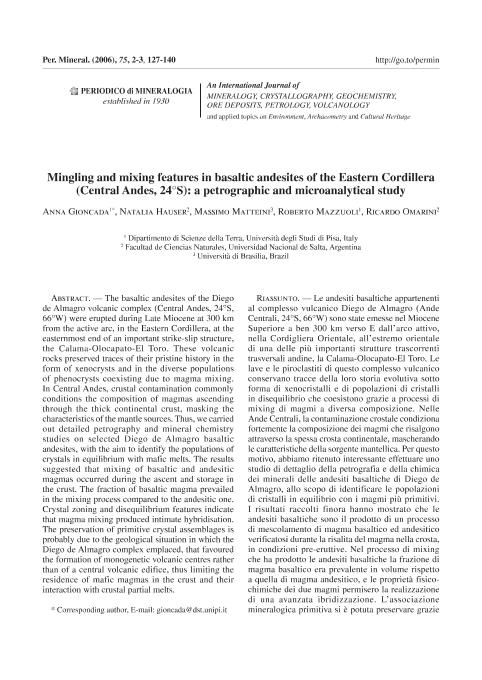Artículo
The basaltic andesites of the Diego de Almagro volcanic complex (Central Andes, 24°S, 66°W) were erupted during Late Miocene at 300 km from the active arc, in the Eastern Cordillera, at the easternmost end of an important strike-slip structure, the Calama-Olocapato-El Toro. These volcanic rocks preserved traces of their pristine history in the form of xenocrysts and in the diverse populations of phenocrysts coexisting due to magma mixing. In Central Andes, crustal contamination commonly conditions the composition of magmas ascending through the thick continental crust, masking the characteristics of the mantle sources. Thus, we carried out detailed petrography and mineral chemistry studies on selected Diego de Almagro basaltic andesites, with the aim to identify the populations of crystals in equilibrium with mafic melts. The results suggested that mixing of basaltic and andesitic magmas occurred during the ascent and storage in the crust. The fraction of basaltic magma prevailed in the mixing process compared to the andesitic one. Crystal zoning and disequilibrium features indicate that magma mixing produced intimate hybridisation. The preservation of primitive crystal assemblages is probably due to the geological situation in which the Diego de Almagro complex emplaced, that favoured the formation of monogenetic volcanic centres rather than of a central volcanic edifice, thus limiting the residence of mafic magmas in the crust and their interaction with crustal partial melts. Le andesiti basaltiche appartenenti al complesso vulcanico Diego de Almagro (Ande Centrali, 24°S, 66°W) sono state emesse nel Miocene Superiore a ben 300 km verso E dall’arco attivo, nella Cordigliera Orientale, all’estremo orientale di una delle più importanti strutture trascorrenti trasversali andine, la Calama-Olocapato-El Toro. Le lave e le piroclastiti di questo complesso vulcanico conservano tracce della loro storia evolutiva sotto forma di xenocristalli e di popolazioni di cristalli in disequilibrio che coesistono grazie a processi di mixing di magmi a diversa composizione. Nelle Ande Centrali, la contaminazione crostale condiziona fortemente la composizione dei magmi che risalgono attraverso la spessa crosta continentale, mascherando le caratteristiche della sorgente mantellica. Per questo motivo, abbiamo ritenuto interessante effettuare uno studio di dettaglio della petrografia e della chimica dei minerali delle andesiti basaltiche di Diego de Almagro, allo scopo di identificare le popolazioni di cristalli in equilibrio con i magmi più primitivi. I risultati raccolti finora hanno mostrato che le andesiti basaltiche sono il prodotto di un processo di mescolamento di magma basaltico ed andesitico verificatosi durante la risalita del magma nella crosta, in condizioni pre-eruttive. Nel processo di mixing che ha prodotto le andesiti basaltiche la frazione di magma basaltico era prevalente in volume rispetto a quella di magma andesitico, e le proprietà fisicochimiche dei due magmi permisero la realizzazione di una avanzata ibridizzazione. L’associazione mineralogica primitiva si è potuta preservare grazie alla particolare situazione geologica del complesso Diego de Almagro, che favoriva la formazione di centri monogenetici piuttosto che lo sviluppo di vulcani centrali, limitando così lo stazionamento dei magmi basici nei serbatoi crostali e di conseguenza l’interazione con la crosta.
Mingling and mixing features in basaltic Andesites of the Eastern Cordillera (Central Andes, 24°s): a petrographic and microanalytical study
Fecha de publicación:
12/2006
Editorial:
Bardi Editore
Revista:
Periodico Di Mineralogia
ISSN:
0369-8963
Idioma:
Inglés
Tipo de recurso:
Artículo publicado
Clasificación temática:
Resumen
Palabras clave:
Basaltic Andesites
,
Eastern Cordillera
,
Central Andes
,
Mixing
Archivos asociados
Licencia
Identificadores
Colecciones
Articulos(CCT - SALTA-JUJUY)
Articulos de CTRO.CIENTIFICO TECNOL.CONICET - SALTA-JUJUY
Articulos de CTRO.CIENTIFICO TECNOL.CONICET - SALTA-JUJUY
Citación
Gioncada, Anna; Hauster, Natalia; Matteini, Massimo; Mazzuoli, Roberto; Omarini, Ricardo Hector; Mingling and mixing features in basaltic Andesites of the Eastern Cordillera (Central Andes, 24°s): a petrographic and microanalytical study; Bardi Editore; Periodico Di Mineralogia; 75; 2-3; 12-2006; 127-140
Compartir




